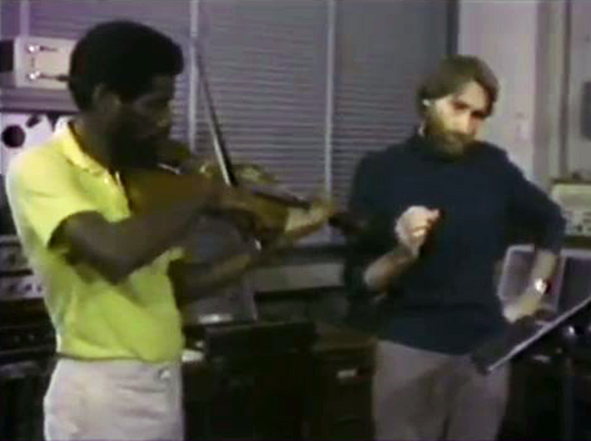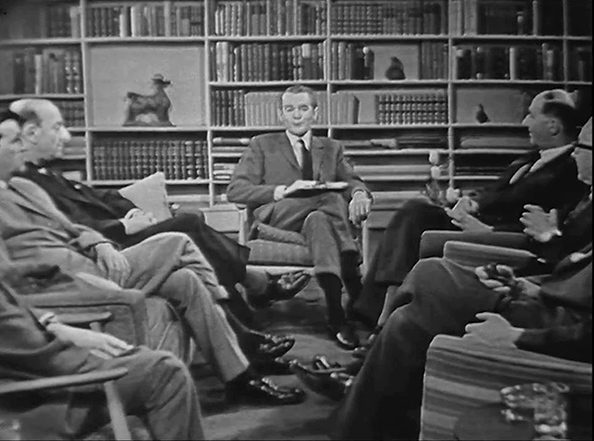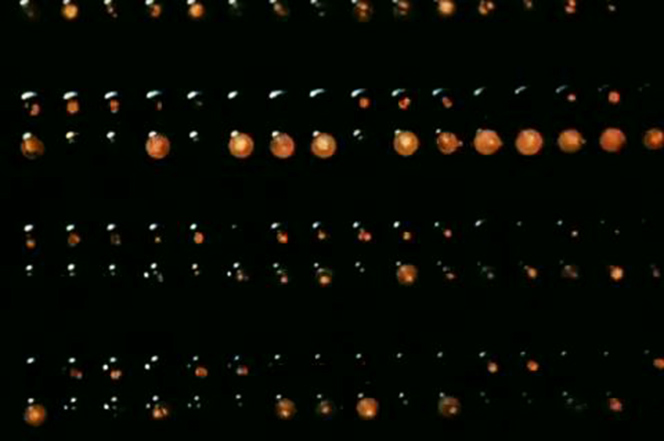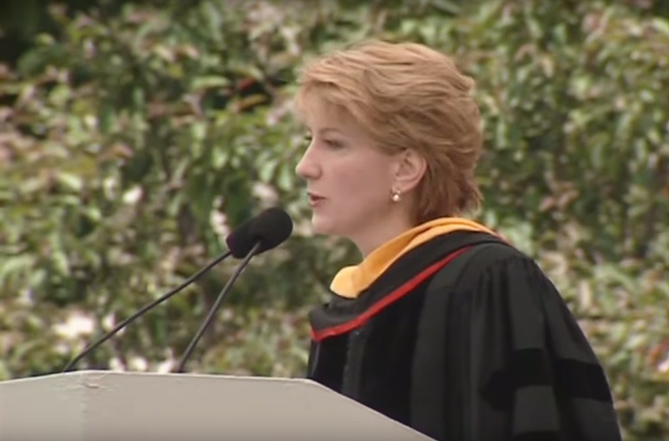MIT Science Reporter — "Landing on the Moon" (1966)
FITCH: You and your co-pilot are a quarter million miles from Earth, guiding your spacecraft down to the surface of the moon. A third member of the flight crew in another spacecraft is maintaining a lunar orbit until you return for the journey back to Earth. As your craft decelerates, you scan the lunar landscape, gliding over craters and craggy mountains. You approach the target area and begin searching for a level spot to land. What this spacecraft looks like and how it operates is our story today on Science Reporter.
[MUSIC PLAYING]
Hello. I'm John Fitch, MIT science reporter. I'm standing on the floor of plant number 5 at the Grumman Aircraft Engineering Corporation in Bethpage, New York. This is a company perhaps best known for its long history in building military aircraft, from the stubby-wing torpedo bombers of World War II to the latest supersonic fighters.
But this company has also received a contract from the National Aeronautics and Space Administration to develop and build the Lunar Excursion Module, or LEM. This is the spacecraft which will carry two astronauts from a lunar orbit to the surface of the moon and back up again. In a moment, we'll have a chance to climb aboard the LEM and actually make a simulated landing.
But first, let's see how the spacecraft fits into the overall Project Apollo mission to place man on the moon and return him safely to Earth.
The Apollo spacecraft will lift off from pad 39A at the Kennedy Space Center. After the first and second stages have separated, the spacecraft will be placed in an Earth orbit. Here it will be checked out by the astronauts and, through telemetry, by the ground mission control center.
At a precise point in the orbit, the third stage rocket engine will reignite and thrust the vehicle out along a path that will carry it toward the moon. During the coast period, the Command and Service Modules will separate from the booster, and using reaction control jets to maneuver in space, will turn around and dock with the LEM nose to nose.
The two will then pull away from the Saturn rocket. The trajectory will be checked and mid-course corrections made. Nearing the moon, the Service Module engine will reduce flight speed so that the spacecraft will fly in an orbit around the moon about 80 miles above its surface.
Two of the crew members will transfer to the LEM, leaving their companion and the Command Module in lunar orbit. By firing its own rocket descent engine, the LEM will be maneuvered to a touchdown on the surface of the moon carrying the two men and their scientific and documentation equipment. While one astronaut explores the area around the LEM, the second remains inside to maintain communications.
When it is time to return, lift-off from the moon will be accomplished by an ascent engine, leaving the descent stage on the moon. The LEM will be thrust back into lunar orbit to rendezvous and dock with the Apollo spacecraft. The two lunar explorers will then transfer back to the Command Module, rejoining their comrade who remained on board the orbiting spacecraft. The LEM will be separated and left behind in lunar orbit, as the other two modules carrying the crew and supplies return to Earth using the engine of the Service Module.
Shortly before reentry, the Service Module will be jettisoned, leaving the Command Module free to reorient for the trip through the atmosphere. Three parachutes will lower the Apollo spacecraft to the Earth at 50 miles per hour.
Even though manned exploration of the moon isn't scheduled to occur until the end of this decade, the hardware for Project Apollo is already being developed at over 5,000 industrial centers scattered across the United States. The Saturn booster is being developed in Alabama. The Command and Service Module are being assembled in California. And the LEM is being built here in New York.
Earlier today, we talked with Mr. Thomas Kelly, project engineer for LEM, and asked him to describe this unusual spacecraft for us.
KELLY: This is a full-scale mock-up of the Lunar Excursion Module.
FITCH: But this will never fly. Why do you have to build such a full-scale model?
KELLY: Well, we need an accurate model in order to check the fit and installation characteristics of all our equipment and also to practice all the operations with the space-suited astronauts. The vehicle, as you can see, is a two-stage spacecraft. The upper stage we call the ascent stage. This is the inhabited portion of the spacecraft and also contains the majority of the electronic equipment.
The lower stage is called the descent stage, and it's primarily used during the lunar landing. The descent stage contains the descent propulsion system, which consists of the descent rocket engine and the tanks and pressurization equipment that supply it with propellants.
FITCH: Right.
KELLY: In addition to that, we mount all equipment which we can leave behind on the lunar surface in the descent stage, such as the scientific equipment that the astronauts will use in their lunar surface experiments.
FITCH: You don't want to take anything back that you don't have to.
KELLY: Right. We want to save the weight as much as possible by leaving behind what we don't need. The other major component of the descent stage is the landing gear. We can get a better look at the gear over here.
FITCH: This leg over here appears to be sort of folded up.
KELLY: Yes. It's showing the retracted position. All four of the landing gear legs will be retracted in this fashion while the LEM is stowed inside the spacecraft adaptor. The adapter mounts the LEM to the Saturn booster vehicle.
FITCH: All right.
KELLY: Now, after the adapter is jettisoned, all four legs will be deployed by means of a spring-loaded mechanism. Now, I can demonstrate the deployment of this one leg right here. I'll release this demonstration pin, and the spring-loaded mechanism will deploy the gear. In the actual case, this pin release is performed by an explosive device.
FITCH: That's out there and locked in position.
KELLY: Right. The gear stays locked. All four gears stay locked for the remainder of the mission. Now, over here we have the scientific equipment bay. This houses some of the typical experiments that the astronauts will conduct after they land on the lunar surface. We can remove the panel here and show some of the representative equipment.
FITCH: You mean the astronauts would get down out of the spacecraft, come around here, and take out these--
KELLY: Yeah. You see--
FITCH: --equipment?
KELLY: --these boxes are removable. And depending on what experiment they were conducting, they would take the boxes out and lower them down to the surface.
FITCH: Well, now what sort of experiments would they perform?
KELLY: Well, some of the typical scientific experiments would involve seismological measurements, looking for moon quake on the lunar surface. Measurements of the lunar atmosphere.
FITCH: Oh, really? I didn't think there was any atmosphere on the moon.
KELLY: There is calculated to be a very tenuous atmosphere on the lunar surface. In addition, the gravitational and magnetic fields would be checked with this equipment. These boxes here are concerned with geological measurements in which we would analyze specimens right on the lunar surface and, in addition, take specimens back with us in sealed containers, return them to Earth for further examination.
FITCH: I notice this panel over here says something about a TV camera.
KELLY: Yes. We can look inside this one. This houses the cables for various antenna that we set up on the surface. And also the TV camera, the portable TV camera that the astronauts will carry with them out onto the lunar surface.
FITCH: Does that mean that people on Earth will actually be able to see what's going on with this?
KELLY: They will see real-time television transmission of the activities on the lunar surface. These cables will be connected to antenna and to the handheld TV camera respectively.
FITCH: It's going to be a very exciting event.
KELLY: It sure will be. If we look down below the stage here, we can see the skirt of the descent rocket engine, which projects below the base of the descent stage. Now we have a full-scale mock-up of the descent engine over here. This is the skirt that we saw on the spacecraft mock-up. And above it are the combustion chamber and the plumbing and hardware, which control the flow of propellants into the rocket engine.
FITCH: You mean you can control how much thrust you get from this engine?
KELLY: Yes. Because of the lunar landing requirements, this must be a throttle-able engine so that we can control the thrust to let the vehicle down gently on the surface.
FITCH: I see.
KELLY: Over here is the ascent engine. This engine is used to lift the ascent [INAUDIBLE] off from the moon and place it into lunar orbit.
FITCH: It looks like an awfully small engine to be lifting that whole upper stage.
KELLY: Well, it's more than adequate to supply the required thrust when you consider that the gravity on the lunar surface is only 1/6 that of Earth. So we don't need a lot of thrust, and we can get by with a relatively small package. Well, now we can see the ascent stage more clearly if we go over to the other side of the vehicle. Here we see the side of the ascent stage, which has the thermal shielding removed.
FITCH: What do you mean by thermal shielding?
KELLY: The thermal shielding is the shiny skin that you see on the left there. It's used to insulate the spacecraft to protect it against the temperature extremes in outer space. It also serves as a bumper against the tiny micrometeoroid particles.
FITCH: What do you have in these racks here, these long vertical things?
KELLY: This is electronic equipment bay. Those long boxes are electronics, which are packaged on a water/glycol-cooled cold plate.
FITCH: Because electronics get too hot.
KELLY: Yes. It's to remove the heat from the electronics.
FITCH: And what would you have in there? What sort of electronics?
KELLY: We have the rendezvous radar electronics, also the autopilot, communications, and instrumentation equipment. Directly up here is one of the four reaction control jet clusters. There are four small rocket engines in each of the clusters.
FITCH: Each of the little ones is a rocket engine?
KELLY: Yes. They're 100 pounds thrust each, and they can fire very short impulses. They're used to maneuver the spacecraft and position it in whatever attitude we desire. Here you can see the cylindrical tanks that supply the reaction control jets with propellant. Also, the large spherical tank is the oxidizer tank for the main ascent engine. The fuel tank is on the other side, and the ascent engine is in between.
FITCH: Okay.
KELLY: Now, up above here is the S-band steerable antenna mounted on the tripod. This is a communications antenna, which aims at the Earth's tracking stations and transmits data back to Earth throughout the mission.
FITCH: Including those television pictures the astronauts might be taking?
KELLY: Yes. Now, up at the front of the vehicle is the rendezvous radar antenna. This is also steerable, and it's used to aim at the Command and Service Module during the ascent and track them throughout the rendezvous maneuvers. The platform and ladder here are used by the astronauts in descending from the spacecraft to the lunar surface. Now, we'll reverse the process and go on in.
FITCH: All right.
KELLY: This is the inside of the LEM crew compartment. We've mounted a mirror back here so you can better see the internal features. This is the upper docking hatch through which the astronauts will enter the LEM from the Command and Service Module. They will step down here on the ascent engine cover. The engine we looked at before is right on the other side of this cover.
FITCH: Right.
KELLY: They will then hook up their spacesuits to the LEM environmental control hoses located here.
FITCH: Is that how they get their air and cooling and things like that?
KELLY: Yes. That's how they control their personal comfort, and their air supply is controlled on these manual valves located in this area. Now, when they're out on the surface, of course, on the lunar surface, they must unhook from those umbilical hoses, and they wear this backpack. Each man has a backpack on the back of his spacesuit. One of them is mounted here. The other one is on the back of the forward hatch.
FITCH: And this will provide them with enough oxygen to move around for a while on the moon?
KELLY: Yes. It makes them completely mobile on the lunar surface.
FITCH: What keeps them from sort of rattling around in here while they're trying to land and take off?
KELLY: They're lightly restrained by a window washer-type belt around the waist. Now, here is the flight station itself. The astronauts are in a stand-up position. You're in the commander's location.
FITCH: Right.
KELLY: I'm standing here in the copilot's location. Either astronaut can fly the vehicle. They share the critical flight controls. And they both have complete visibility of the landing maneuver through the triangular windows. The other window, the small window over your head, is used during the docking operation.
FITCH: Oh, when we're rejoining the Command and Service Module.
KELLY: Right. This is the alignment optical telescope, which is used to align the inertial guidance system prior to lift-off from the lunar surface.
FITCH: Well, how soon will the astronauts be able to actually fly these LEMs?
KELLY: Well, they'll never be able to fly an actual LEM on Earth due to the difference in the strength of the gravitational field on Earth as compared to the moon. The LEM doesn't have enough thrust to actually fly on Earth, even though it can fly very well on the moon. So much of our flying and practice landing will have to be done in simulated flight conditions and in carefully controlled simulations.
SMYTH: Just follow me.
FITCH: This is test pilot Bob Smyth of Grumman entering the LEM simulator. We had the unique experience of riding with him during a recent test flight.
SMYTH: John, this is one of our LEM simulators, where we draw engineering design tool to be used in developing the Lunar Excursion Module.
FITCH: That's so you can see whether the controls will actually allow you to fly it properly?
SMYTH: Yes, right.
FITCH: But this room doesn't move, does it?
SMYTH: No, it doesn't. It's a fixed-base simulation. The cockpit we're standing in doesn't move. The displays do move, however, these internal displays and also our external display which is a TV monitor.
FITCH: Well, what do you see on that?
SMYTH: We see the motion of the vehicle. I'll tell you how it works. The pilot stands on the flight station. And he moves the control and works through a computer, which is an analog computer in the other room, which in turn flies a television camera over a lunar map which is in another room.
FITCH: Oh, and then you see the output of that camera here.
SMYTH: Yes.
FITCH: So that as you move it, it looks like you're flying.
SMYTH: Flying by camera.
FITCH: Is it very realistic?
SMYTH: It's realistic, yes. It's a 6-degree-of-freedom simulation. We accurately represent pitch, roll, and yaw the vehicle about its three axes and also translation along these axes, in other words, up, down, fore and aft, and laterally.
FITCH: Now, does the astronaut fly the LEM all the way down from the orbit around the moon?
SMYTH: No, he doesn't. This is done to save-- he could, but it's done to save fuel by an on-board navigation system, a computer, which flies it down to a manual takeover point. Now in this particular simulation, we're simulating the astronaut taking over at 225 feet.
FITCH: Right.
SMYTH: You notice we have an instrumental panel and altimeter up here. We start the problem on the automatic system at 410 feet. And as it comes down to 225, I will move the switch and take over manually and fly to what I consider with my eye to be a satisfactory landing place.
FITCH: I see. And what about these other instruments up here?
SMYTH: This is a 3-axis attitude instrument or an 8-Ball. It right now shows that we're pitched at 45 degrees and the problems starts where we're not in the braking phase of this landing maneuver. We start at many thousands of feet per second in lunar orbit we're braking down to an actual 0, 0 at touch down.
FITCH: And so we're sort of lying on our backs, and it's thrusting out in front of us to slow us down. And the other device?
SMYTH: This shows our velocity along the lunar surface. The horizontal needle for forward velocity, and the vertical needle for lateral velocity.
FITCH: And so you want to get those down to a minimum by the time you're going to touch.
SMYTH: Absolutely.
FITCH: Well, could we actually make a landing?
SMYTH: Yes indeed. I use this headset to be in touch with the people at the computer.
TECHNICIAN: Yes.
SMYTH: We're ready for operate.
TECHNICIAN: Yes, we are.
SMYTH: Operate.
FITCH: Oh, we're dropping down rapidly, 360, 350 feet?
SMYTH: The altitude is increasing. At 250 feet, I'll change scales on this horizontal velocity indicator to times one.
FITCH: Here comes the moon.
SMYTH: Scale changed and manual takeover. At this point, I pitched down.
FITCH: So now we're sort of standing straight up.
SMYTH: We're standing--
[INTERPOSING VOICES]
SMYTH: I nosed over a little bit. It's a stress factor control, similar to the way you fly a helicopter. You have an engine at the bottom. And you're tilting that engine thrust factor to cause motion across the lunar surface.
FITCH: How long could you fly before you sort of ran out of fuel?
SMYTH: Well, several minutes.
FITCH: That'd give you time to pick out a nice spot to land on?
SMYTH: Hopefully, yes.
FITCH: Then you'd want to what-- say like the bottom of a crater or something where it would be relatively flat with a kind--
SMYTH: Any flat place outside of a crater or perhaps in a crater. I don't like to land in a crater for reasons of communication with the Earth.
FITCH: Oh, I see. When they will talk over the sides of the mountains.
SMYTH: I think I see a relatively flat spot. We'll pitch the vehicle up. Peel off what forward velocity we have.
FITCH: I see our L sort of sticking out in front of us a little bit again.
SMYTH: Yes. We're now coming to about 10 feet per second.
FITCH: And we're still 65 feet up in the air. Well, what air.
SMYTH: Yes.
FITCH: There's isn't any air, I guess. But anyway.
SMYTH: We're almost stationary with respect to the lunar surface. But at 0,0, our forward and lateral velocity, and now, we'll start descending again.
FITCH: So you're not moving forward and you're not moving to the side.
SMYTH: Just going straight down.
FITCH: Straight down. Now, do you fly it all the way down to touch down?
SMYTH: Almost all the way. We have a probe that tells us when we're a certain distance above the moon. And at that point, we shut the engine off.
FITCH: Oh, and just drop the rest of the way.
SMYTH: Yes.
FITCH: That won't damage it?
SMYTH: No.
FITCH: It's 20 feet.
SMYTH: Whoever's designing it. I've got you at 10 feet.
FITCH: 10, 8, 6, 4.
SMYTH: [INAUDIBLE]. Shut-off.
FITCH: Oh, and then we just drop down to the bottom.
SMYTH: We're done.
FITCH: Well, that felt like a very soft landing. I assume that you can get us back up to the orbit around the moon.
SMYTH: We can, [INAUDIBLE] pushing it out a bit.
FITCH: Well, that's very interesting. Thank you very much.
Although the simulator we've just seen is firmly rooted to the ground, engineers at NASA's Langley Research Center in Hampton, Virginia have built a LEM simulator which actually flies. This is the lunar landing research facility developed to study techniques for landing LEM on the moon. This gantry structure is 250 feet high and 400 feet long. An overhead crane simulates the reduced gravity of the moon by supporting much of the weight of the research vehicle.
The vehicle has hydrogen peroxide rocket motors to provide the main thrust and attitude control. The attitude thrusters give the simulator complete mobility within the confines of the cable support system. When all systems are checked out, the research vehicle takes off and essentially duplicates the motions of LEM on the moon.
The craft can fly at speeds up to 17 miles per hour and can travel 400 feet downrange, 50 feet cross-range, and 180 feet vertically. Later modifications will make it possible to catapult the vehicle downrange at 35 miles per hour to simulate the approach to the moon's surface.
In flight, a vertical lifting force equal to 5/6 of the vehicle's weight is applied by two support cables to oppose the Earth's gravity and simulate the low gravitational force at the moon's surface. The cables are attached to an overhead hoist and a dolly unit mounted at the top of the gantry structure.
As the vehicle moves downrange or cross-range in response to the pilot's controls, the dolly overhead responds to signals from the vehicle and to cable angle and load sensors at the top of the cables. This enables the dolly to remain directly over the flight vehicle at all times, keeping the cables vertical.
The simulator, though it is not an exact replica of the Lunar Excursion Module, is essentially the same size and weight as the LEM and is designed to handle in the same way LEM is expected to. The ultimate purpose of the lunar landing facility at Langley is to reproduce as nearly as possible a lunar situation in order to study all aspects of rocket-powered lunar flight.
After each LEM has been built and tested, its performance capability can be constantly checked right up to the moment of launch. We talked again with Mr. Thomas Kelly in the automatic check-out area.
KELLY: This is the LEM automatic check-out equipment area. This equipment is connected to the LEM and is used to conduct the various tests during the development phase and will also be used in pre-launch operations at Cape Kennedy.
FITCH: You mean this can actually make measurements automatically and decide whether they're right?
KELLY: Yes. It's a computer-controlled system that stores test commands for the spacecraft and then compares the answers to determine whether the spacecraft has passed the test or not.
FITCH: So you don't have those men in their white coats going around with clipboards and the volt meter?
KELLY: Right, right. It's a very capable system in that it can handle some 4,000 to 5,000 test sequences. It can measure several hundred individual measurements at once or sample something like 25,000 measurements per second.
FITCH: It's really more than humanly possible.
KELLY: Right.
FITCH: Is that the idea?
KELLY: Yes. It decreases the time required for the whole shut-down operation greatly.
FITCH: Well, now if you need all this equipment to check out the LEM, what must you need for the whole Apollo mission?
KELLY: Well, you don't need very much more at Cape Kennedy for the complete complex of the Saturn booster and the Command and Service Module. That's because each portion of the [INAUDIBLE] equipment is computerized and modularized so it can all go together at Cape Kennedy in a very efficient fashion.
FITCH: Could we actually see how it makes some of these measurements?
KELLY: Yes. We can take a look here at the test conductor's console. You see the individual operators at the various consoles have equipment very similar to this test conductor display we show here.
FITCH: I was wondering why there were so many operators if this is an automatic check-out equipment.
KELLY: Well, they're used during the development phase of the program, where we're going into considerable detail on individual tests. They wouldn't be needed at Cape Kennedy.
Now, what we have on each console is a cathode ray tube display of the so-called test library. We can turn pages in the test library by turning this wheel. Now, here I've pulled up page 6 in the test library. And I can read such things as helium tank pressure and temperature, fuel and oxidizer valve position, or the AC bus voltage.
Now, for instance, item 13, the AC bus voltage, I can insert a command here which will cause this voltage to go through a particular test sequence. Test console 1, execute step 2. Now, what we've done there is come up a voltage reading of 83 and 1/2 volts, which is within limits for this particular test.
FITCH: Well, thank you very much, Mr. Kelly. The first landing of this LEM on the moon will certainly be one of the brightest chapters in the relatively short history of manned space flight. But in a broader sense, I suppose, it's only a continuation of man's age-old desire to fly, a quest that has tantalized him for centuries.
Leonardo da Vinci, who visualized man's flight 500 years ago, experienced the same fever when he wrote, "Well, once you have tasted flight, you will walk the Earth with your eyes turned skyward, for there you have been and there you long to return."
This is John Fitch, MIT science reporter.
[MUSIC PLAYING]




























